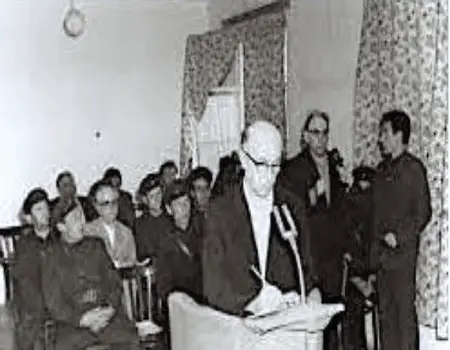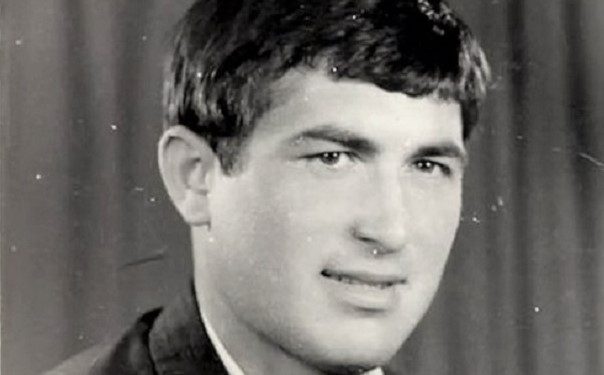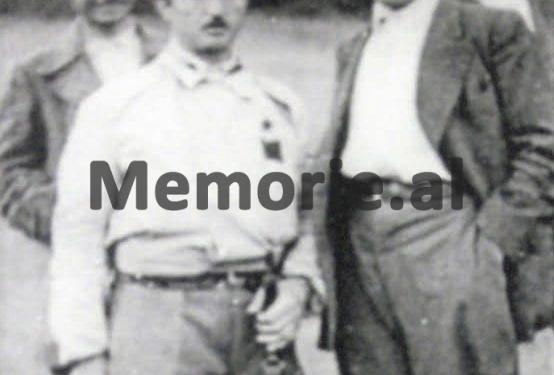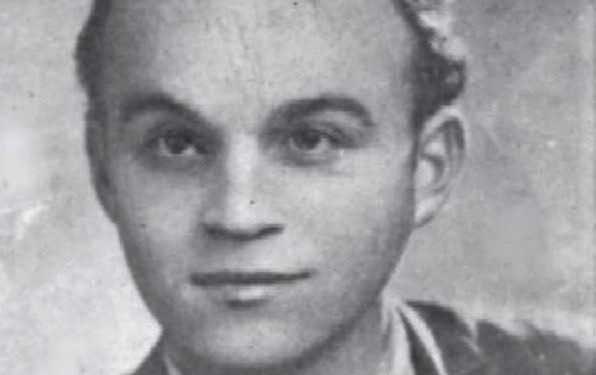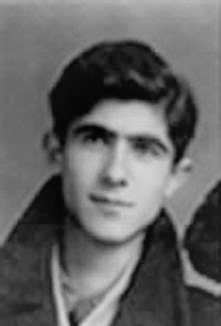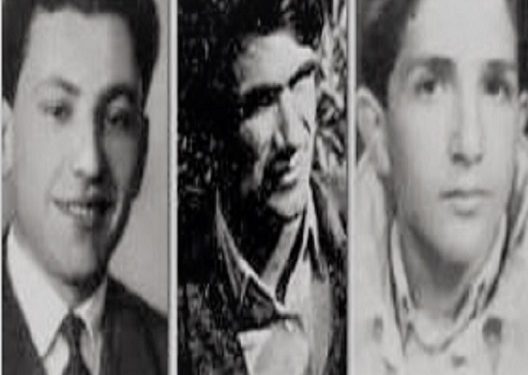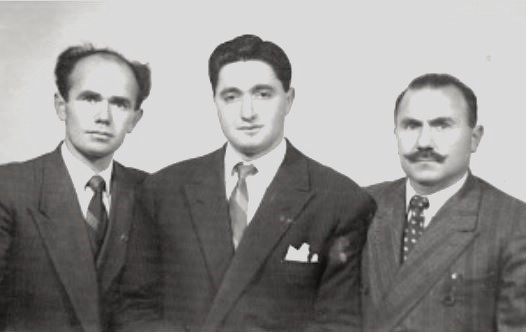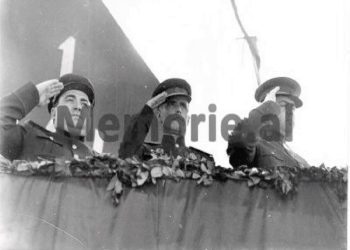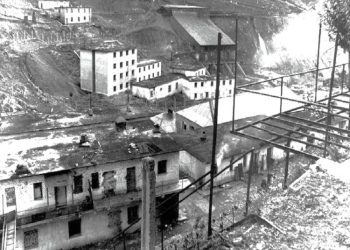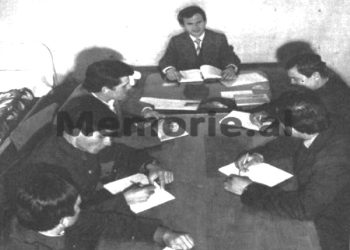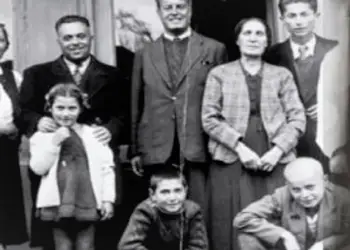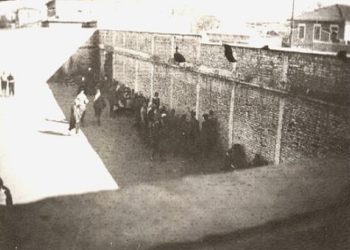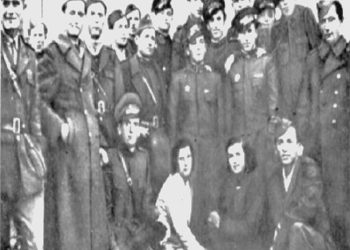Part eight
Memorie.al/ publishes a study conducted by AIDSSH (Authority for the Information of Former State Security Documents), titled; “DISAPPEARED – INSURANCE IN OWN WORDS”, 19 INSURANCE BRANCHES, 3299 LIFE, 1 HISTORY’, in which the ‘History of State Insurance’, which belongs to a period of time from 1943 to 1991, is used. where 19 branches of the State Security are included, from the districts: Durrës, Kolonje, Burrel, Krujë, Lushnje, Dibër, Gramsh, Pogradec, Korçë, Tepelën, Elbasan, Lezhë, Saranda, Gjirokastër, Vlorë, Shkodër, Tropojë, Skrapar, Librazhd and Tirana.
Entry
INSURANCE IN OWN WORDS
“Those who think that communist regimes are the work of criminals only, overlook a fundamental truth: criminal regimes were not formed by criminals, but by convinced enthusiasts…”!
Milan Kundera, “The unbearable lightness of being”
Continues from last issue
Skrapar
The basement lights
A dog and a cellar. They met a villager who hides and reports. Days later, another villager guards and reports. In the end, communism that knows no end and two brothers’ victims.
In January 1945, State Security learns through an associate that in the area of Tomorrica, in Vidhan village, the fugitive R.B. was seen, who had arranged a basement in the ground for living, and as a security measure, used a dog, which, when he stayed in the cellar, he let go and when he left, he tied it. “The informant’s trustee called a villager from Vidhanji and charged him with the task of notifying him when the fugitive was in the basement. After a few days, he informs him, a siege was organized by the People’s Defense Forces, he was caught and executed, together with his brother”.
The suicide of Dervish Kapllani
“Better dead than in the hands of the Security”! In January 1945, a villager from Zaloshnja informed the People’s Protection Authority that Dervish Kapllani, who had fled to the mountains, was staying in S.M.’s house. The security organized the operation to capture him, but it failed, because he ran away. During this time, one of the host’s relatives was arrested, who stated that Dervish Kapllani had been in his house and then left for Gradec village, to S. Gj.
Called by the State Security, S. Gj., stated that Dervish Kapllani had left for Faqekuq village, but from the information received from the people, the State Security learned that Kapllani was in Krastë with B. Gj., who immediately informed the post office the police in Potom. “From the People’s Defense Forces, the siege was organized and the criminal was caught and, accompanying him to Çorovode, on the way he cut open his stomach with a razor that he had with him and died.”
Parachutes stopped by bread
In the book “CIA and MI16 operation in Albania, 1949-1953”, Sefer Muço, one of the fugitives who secretly returned to Albania to instigate the uprising, confesses that one of the times, when he entered the country with Sami Bardhë, Bardha went to see her mother, she talked to some people, the Security found out and they killed her. “They also caught me”, adds Muço. His explanations for the situation in Albania coincide with Skrapar’s History of Security, as far as the killed are concerned, but not extreme poverty.
“It was more dangerous than in 1949, more dangerous than in 1950. There was not enough bread, everything was rationed and people were scared.” From the historians of the Security, the information about the arrival of Ali Turbohova with others appears several times. “In September 1949, the English Discovery, via Italy, sent the gang led by Ali Turbohova, consisting of five people, which circulated for a while in Lushnja and Berat. They were dictated in Brezenckë village, where one of the members, M. H., had his family members. An ambush was organized for this gang, but due to poor organization and because both members knew the area well, they managed to leave.
Later, information was received that M.H. was able to go to his house to meet his father and brother”.
Turbohova had been a militia captain, then a partisan. It was accused that on June 22, 1943, he had killed the commissar of the detachment Ramis Aranitas, a key figure of the Security during the War. Then he would spend time with Balli, to return several times with missions, in collaboration with the Anglo-Americans.
Brother’s murder
According to the book published by Nicholas Bethel, “CIA and MI16 Operation in Albania, 1949-1953”, in August 1951, a group of fighters who wanted to see Albania free, were sent to the country. “Tefik Kokla was the leader and the group included Ali Turbuhova, Muharrem Hito, Baki Ermenji and Muço Çeprati. They went by boat. The communist forces met, Kokla was killed, while Çeprati was captured”.
The security narrates the event in his prism: “The killing of the leader of the gang, Tefik Kokla, by Gramsci’s forces, as well as the execution of two of its members in the Potomi area, showed that it was involved in different directions. At the time when Aliu, B.p., “Dafina”, who worked as a miller in the area of Çepan, was expected to be captured in Turbohova, reported that in Blezenckë, the fugitive Muharrem Hito was dictated to. For his capture, all possible ambushes were taken and, in the evening, above the village, when his brother Zaim Hito brought him food and was returning to his family, he was killed by these ambushes “because they thought it was Muharrem Hito. Muharrem took advantage of the opportunity and managed to leave”!
BOOKMARK
“The weapon of the State Security is the steel hand of the people that builds socialism. Make her invincible and raise her glory higher and higher.” Enver Hoxha
War liquidations
The informational network organized during the National Liberation War, also developed the war within the type, alongside the liberation one and the one with ‘Balli’. In this framework, describing it as a war for “preserving the purity of the ranks of the partisans from the penetration of enemy elements and spies, who were put at the service of the occupier”, they follow D. Z. from the village of Farret, part of the partisan battalion of Bërzeshte.
For State Security he soon became an enemy, since during the June Operation of 1944, following the instructions he had received, he began propagandizing about the impossibility of winning the National Liberation War and encouraging the partisans to desert from the ranks of the partisan battalion, said that the Germans were invincible and that they would emerge victorious. “As a result of these, measures were taken by the Security, to strengthen the information network, where it was possible to discover the hostile activity of the spy, and by court decision, the partisan was sentenced to be shot.”
“The Ruin and Fall of the Butcher”
Azem Çela was killed and Jakup Çezma was injured, when the People’s Protection unit surrounded the place where they were. “The unit was persistently seeking the clearing of the enemies in the Qarrishte area, where they had information that there were movements. The informant “Kasapi”, who was also armed, was placed at the head of the forces that were heading towards Mount Miraku. After they pruned the forest, they found the words carved on a log; “Long live the Biçakçi!” and a little further “the effort began”, a term that State Security uses for armed clashes between opponents of the regime and the State Security Pursuit Forces. “Halil Alla was killed in the fighting, while Isak Alla and Hazis Biçaku were injured and managed to escape. Their leader was killed by the Pursuit Forces”.
When the persecution of poets began
Bardho (Feim) and Nergjize Leka had a son in the village of Bërzeshte in Librazhd, in 1941. Nine years later, in 1950, Bardho Leka escaped and settled in Prizren.
According to the confessions of Bedri Blloshmi, Genci grew up, sometimes with bread and sometimes without bread and constantly barefoot. Together with his two sisters, they buried him in the Tepelena desert. He was able to finish the Pedagogical School in Elbasan, as an outsider, by being hosted by an old family friend.
“In 1959, they opened Genci’s card and followed him closely. The prosecution file continued until August 31, 1976, when Genc Leka was handcuffed, never to be taken off again,” says Blloshmi.
In the History of Librazhd, the name of Bardho Leka appears from time to time. In 1951, State Security has information that he re-entered Albania and was seen in Stravaj. The father of his friend R. Z. admitted to the investigator that he had met his runaway son. In 1952, the “red spy” informant reported on April 5, 1952, that Bardho Leka, together with his friends, D. B. and R. Z., were at the house of D. V. and Sh. Mr. State Security drew up a plan of measures, also studying “the elements that were implicated in the hostile activity, of which the most active were H. B., K. B., I. B., together with N. L. I. B. was found to be the most suitable candidate. , who, on the basis of coercive material, was withdrawn in secret cooperation from our bodies with the nickname “The Suspicious”.
Security admitted that I. B. did not give anything, although he “accepted”. On July 17, 1977, in Librazhd, two poets, Vilson Blloshmi and Genc Leka, were shot. Their story started with the war. “If I am more dead than any living person, well then, I am more alive than any dead person”, Vilson Blloshmi
TEPELLENA
Pinjolli of independence, dies in the isolation room
Under the title; “Discovering and capturing the hostile activity of anti-party elements”, the History of the State Security in Tepelena, among those arrested in various fields, mentions “Ahmet Jegenin, as a link of the conspirators in the field of economy, who died in the isolation rooms “. But a single sentence cannot hide an entire story. Ahmet Jegeni came from a rich family of Dibra. His grandfather, Shaqir Beg Jegeni, had been a delegate in Vlora, for the declaration of Independence in 1912.
The young Ahmeti studied Finance in Modena and in 1939, he refused to take the fascist oath and together with Abdyl Këllez, was exiled to Ventottene and Gaeta. In 1942, he returned to Albania and joined Dali Ndreu, in the Dibra e Madhe detachment. After the war, he held various positions in the administration. From 1949 to 1971, he worked in Durrës where, for a while, he was director of the Sea Port. In 1971, he was transferred to Tirana, as Director of the Foreign Trade Directorate, and in 1975, he was transferred to Tepelena. It is there, when the “economic saboteur group” is attacked in Tirana, at the head of which are the two deputy prime ministers, Abdyl Këllezi and Koço Theodhosi, as well as Kiço Ngjela and Vasil Kati.
“Nevzat Hasnedari and a group from Tirana were waiting for him at the city hotel. They put the irons on him and put him in the dungeons of the prison in Tirana for the whole night. There began the ordeal of torture on him, to accept the charges, but Ahmeti did not accept them. He and Andrea Manço died in torture during the investigation”, says the testimony of his relatives, Tefik and Ardian Jegeni.
In prison it was stated that; “a mistake I made in my youth, that I became a communist”. After being released from prison, Kiço Ngjela went to meet Ahmet Jegen’s wife, Dhurata, telling her that she was proud of the loyal man and the attitude he had taken in the investigation.
Hito Sadiku, the shallow pit on the edge of Vjose
An unfinished portrait of Hito Sadik, tells the story of a man who was orphaned at a young age, lost his sister and brothers, and then fled to America to pursue the American dream! Across the ocean, he is part of “Vatra”, and very soon he is known as “poet”. A close friend of Faik Konica, from him he gets the nerve for controversy, as well as reveals his polyhedral figure. From the secretary of the Albanian consulate in Washington, for 12 years, until 1940, when the war had started, in 1941 he found himself in Italy, not only as a journalist. Two years later, he is associated with the Anglo-American missions and is the mission’s translator. Getting to know Harry Fultz brought him to Albania in 1944. And the motherland became the land of pain. Arrested on May 15, 1947, on the same day as Petro Marko, as his friend and friend of Konica.
Petro Marko’s wife, Safoja, remembered him with pain. “He was arrested at the same time as Petro and I fed both of them in prison. While he was isolated, I received a letter from the woman he lived with in Rome…! Ermioni Violet…. “Please explain to me, where is Hitua…?! I write to him and he doesn’t answer me…?! I didn’t answer her…! They wouldn’t let us…! Anxiety and terror, they were guards…”! One night, the firing squad puts him in front, until a fellow villager pulls him out of death row.
When he gets out of prison, he is homeless. He lives in a mosque in Tirana. Desperate for survival, he returns to Bençë in Tepelena, where he was born and lives alone. He has aged very quickly, although he is only 53 years old. The body has lost its powers. Either beaten in unclear circumstances, or because of the condition in which he lived, one night he was taken to the hospital in Gjirokastra, with a ruptured gallbladder. It doesn’t work. The municipality digs a pit for him, by the bank of the Vjosa river, and it is thought that the autumn rains will take his body with them.
There were still hopes that America would intervene, even though it would be late, since the American Secretary of State who had just taken office, John Foster, had been a friend of Faik Konica. “He is for stopping the progress of communist power…! You will see what he will do against communism. Not me. This plan will take years to be realized…”! Sheriff said to Delvina. Hito Sadiku knew and wrote in the “New York Times” that “the fate of small nations is usually decided by foreign influences. In this direction, the history of Albania presents no exception”.
“The homeland is naked” and the poet without a grave
“If you give me a ball, I will shoot your regime.” The courtroom goes numb, while the poet Trifon Xhagjika knows that the end is near and he had nothing to lose. You had declared the homeland naked, through his poems. Soldier and journalist, employee of the Ministry of Defense and the editorial office of “Warrior”, his journey had started in Peshtan in Tepelena, towards “Normal” in Elbasan, until Tirana became his station and then his grave.
Vangjel Lezhon and Fadil Kokomani would also have friends as journalists. Therefore, when Vangjeli is accused of escaping, very quickly, the accusation builds a hostile group, which also includes Kokomani, Thoma e Stavri Rafaeli, Franko Sara, Robert Vullkani and Trifon Xhagjika, all with a tendency to escape. He had just published the book of poems, “Traces” and his pen was appreciated by Dritëro Agolli and Drago Siliqi. One day, his absence began to stand out. The family members only found out after a few days that he had been arrested.
“Trifon, it seems, had sensed the arrest before. That day, like never before, he did not allow Santa to accompany him to the gate of the house, with the excuse that he was waiting for him outside a work “Jeep”. He told you that he was going to a service in Vlora. “Trifon was handcuffed for agitation and propaganda against popular power. They had arrested him for the decadent literature he created…” said his sister, Sotira, a few years ago.
It was August 1963, when he was arrested and sentenced to be shot, together with Thoma Rafaeli. The decision was executed in December 1963. It is still unknown where his remains are.
Brothers, you were looking for the Motherland,
I have it.
Help him laugh,
Help him to rejoice,
The homeland is naked”
Trifon Xhagjika
Suppression of an uprising
History knows it as the Zhapokika uprising group, State Security as; “the gang of Xhemal Ibrahim and Bajram Kamber”. The uprising of Zhapokika was an armed revolt, organized in the south of the country, in the months of September-October 1948, by a group of anti-communists from the area of Tepelena who, dissatisfied with the government and oppression, were forced to attack the dictatorial regime. Among them, there were former partisans, former nationalists, employees of the local administration of the area. The uprising was among the first strong anti-communist movements in the south. It was headed by Xhemal Brahim Asllani, a former partisan.
State Security, in its history, relays the event telegraphically: “After 48 hours of fighting, this reactionary group was completely defeated. Of the 37 people that this reactionary gang had, 5 people were killed, 32 were captured and only one member of this gang, Xhemal Brahimi, was able to escape and escape abroad. Of the people caught, they were sentenced by the People’s Court, with the decision of 6.7.1949 – 2 people were shot, 25 to 2 years in prison, according to the degree of guilt, 20 people and 10 others were released. The Security Section pulled 2 of them into service, in order to control their activity in the future”.
Remaining on the run, but inside Albania, was Brahim’s right-hand man, Bajram Kamberi. For his capture, State Security admits that he made a combination (a term that means a trap with accomplices). A friend of his, a shepherd from Përmet, who had a stall, was drawn into the service. Commander Bajram Kamberi was sentenced to be shot and executed on July 21, 1949, in Gjirokastër. While Brahim’s family knew about exile and prisons.
The hostile group of the priest of Lekli
The orthodox cleric, Gjergj Suli, was born in Lekël and, after his studies in Zoisimea, he went to the USA, where he was ordained a priest. Acquaintance of Noli and the Vatra group, in the 1930s, he returned to Albania and served in several villages. Opponent of the fascist occupation and skeptical of the Bolshevik approach that smelled in the country, quickly caught the eye. Security documents charge a resident of the village, who has denounced Gjergj Suli, as a “criminal”.
“In 1946, Kaso Ismaili ran away from the village of Dhemblan and created a gang with Ramadan Çaushi and Shefqet Hana, who joined the group headed by Gjergj Suli. This gang was immediately pursued by the Security authorities and in cooperation with the people, it was managed to be annihilated within 1946”. The priest was sentenced to be shot and executed in January 1948.
“As a result of the war waged by the State Security bodies, against war criminals and armed gangs, it was possible to discover and capture 27 people, out of 42, within 1948. Of these, 21 were executed and 6 were sentenced to different terms, 12 people were able to escape abroad, while 3 people, it is not known what happened to them”.
7 saboteurs are destroyed, while 7 others, with Izet Vrazhdon, return to Greece. Mit’hat Maze, wounded and separated from the group, goes to the village of Salari and seeks shelter from V. B., who was armed by the Internal organs. V. shoots Mit’hat and wounds him again. The wounded man comes into contact with a relation of his own, who shelters him and helps him, but injured, he could not stay long in the cave and his relation asked for help from B.p., ‘Armata’, who informs the section of Security, for the place where Mit’hati was sheltered and for his capture, a combination was organized with B.p. “Army”.
The aim of the hostile activity has been: to oppose the directives of the Party and the government, to try to divide the unity of the people and to gather discontent and uncertainty in the existence of the popular power, with the hope of changing the situation through foreign intervention, especially after the occupation of Czechoslovakia.
Enemy elements have tried to extend the hostile activity even to young people, inciting promiscuity in school, family and acts of vagrancy up to treason against the motherland. In the ranks of school youth, materials with hostile, liberal and pessimistic content, foreign songs, etc., have been introduced, with the aim of degeneration.
Until 1971, the results in the detection, attack and prevention of hostile and malicious activity were low, so only 12 were recorded, and these were processed by agents 2/A, the arrests were few. 1 in 1967, 1968, no hits, 2 in 1969 and 2 more during 1970-1971.
9 people were exposed and 21 others were advised. In 1972 and later, an organized and efficient work was done both in the detection, as well as in the attack and prevention of hostile activity, where there were 19 processings with 2/A, 3 P.P, (Preliminary processing) 82 in operational control 2/B and 229 people in the contingent. In 1973, there were 18 in agent processing 2/A, 11. P.P. 86 in 2/B and 236 in contingent. Memorie.al
The next issue follows




